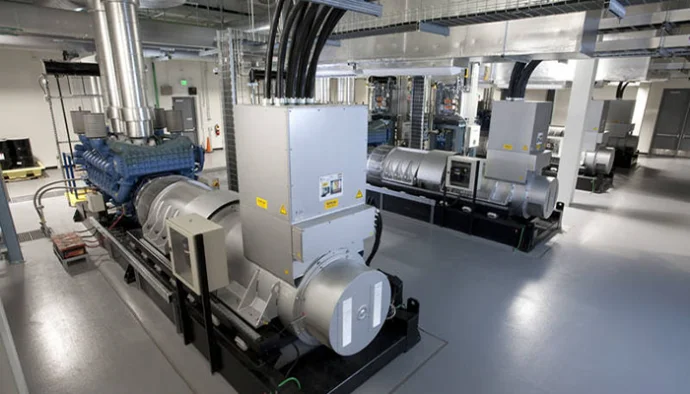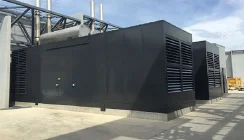How UPS Systems Compare to Standby Power Generators
There are times when designing a backup power plan that our projects team will recommend a UPS system combined with a standby power generator. There are several differences between these two devices and whilst an uninterruptible power supply can be used without a generator to protect IT servers and network devices, a generator cannot provide the same level of protection in terms of a break-free and as pure an output supply.
Prime and Standby Power Generators
Generators may be diesel or liquid petroleum gas (LPG) powered and can be installed to operate in ‘Prime Power’ or ‘Standby Power’ mode. In Prime mode, the generator powers the load constantly and the mains power supply (if present) is used as a back-up power supply. In Standby mode, the generator is only powered up when the mains power supply fails.
On-line UPS Systems
UPS systems provide two types of power protection. When the mains power supply is present, the UPS will provide filtering of spikes and electrical noise and smooth out sags, surges and brownout conditions. When the mains power supply fails, the uninterruptible power supply will provide power to the connected load from a stored energy source; normally a valve regulated lead acid (VRLA) maintenance free or lithium-ion battery set.
The UPS may be a standby, line interactive or on-line system. On-line uninterruptible power supplies are recommended for critical IT loads due to the quality of their output waveform and continuity; whether powered via the mains power supply, battery set or a standby power generator. This type of UPS is often referred to as a ‘double-conversion’ (AC-DC-AC) or ‘triple-conversion’ (AC-DC-DC-AC) system.
In an online UPS, when the mains power supply is present, a rectifier-charger section converts the incoming mains power supply AC (alternating current) to a DC (direct current) supply which is used to power a battery charging circuit and the output inverter. The inverter ‘inverts’ the DC power to create a digitally generated AC sinewave output from which to power the connected loads. Should the mains power supply fail or fluctuate, the inverter is supplied DC power from the battery set. Capacitance within the UPS is used to ensure a ‘no-break’ supply to the input of the inverter section and the load is supplied a pure and uninterrupted supply. An on-line UPS also features a built-in automatic bypass switch. Should the inverter output waveform start to collapse due to an internal fault or overload short circuit, the bypass switch instantaneously transfers the connected load to mains power or generator supply (whichever is present).
Generator and UPS Combination Systems
As a standby generator can take several seconds to come up to full speed (power), it is normal practice in critical infrastructure environments to use a generator and UPS system combination.
The UPS system is installed in-line between the mains power supply and the load(s). A generating set is connected to the mains power circuit and monitored via an automatic mains failure (AMF) panel. When the mains power supply fails, the AMF panels signals the generator to start. The UPS uses its battery set to power the load until the generator can provide a sufficiently stable supply in terms of voltage and frequency. At this point the UPS synchronises to the generator output and the remaining battery charge conserved or recharged.
When the mains power supply returns and proves stable, the UPS synchronises to the waveform of the mains power supply. Once connected the generator is instructed to power off and the UPS now supports the critical load. The battery set is recharged, and the generator is in standby mode once more awaiting then next power interruption or outage.
UPS Battery Set Runtime
If a generator can take up to 30seconds or less to reach full power, why are uninterruptible power supplies installed with 10-30minute batteries? One answer to this is that it is difficult to size a UPS battery to provide only 1-2minutes of backup power. In this instance supercapacitors or a DC flywheel can provide alternative power sources to UPS inverter.
Up to 30minutes is quite a common battery runtime requirement in server room and datacentre environments. In practice the period of up to 30minutes is not long enough to power down a larger server facility or datacentre. However, this period can provide enough time to investigate a generator start-up failure. This is not uncommon and may be due to a low charge on the starter battery or a breaker left open from a generator service visit. For this reason it is normal practice to start-up a generator once a month for testing and to provide 6monthly preventative maintenance visits by certified engineers.
Summary
Critical IT loads cannot be connected directly to the output a generator due to the start-up period which can result in a power outage to the load. The output from the generator during start-up and power down can also present electrical noise and spikes to the critical load power supply. The use of a UPS system between the critical load and the generator provides filtering and protection from these types of electrical disturbances as well as a stable output supply (using battery power) as the standby generator is brought into and out of circuit.
UPS and generator combinations have traditionally been the most popular choice for short and long-term power outage protection in server rooms and datacentre applications. New developments such as lithium-ion batteries and local renewable power generation are providing further options as their technologies develop.


























